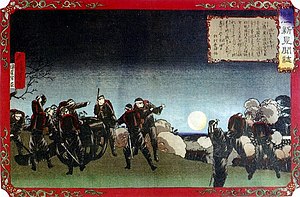Saga Rebellion
| Saga Rebellion | |||||||
|---|---|---|---|---|---|---|---|
| Part of the Meiji period | |||||||
 An ukiyo-e of the Saga Rebellion | |||||||
| |||||||
| Belligerents | |||||||
|
Meiji Government
Imperial Japanese Navy | Rebels of former Saga Domain | ||||||
| Commanders and leaders | |||||||
| Yamada Akiyoshi |
†
†
† | ||||||
| Strength | |||||||
|
906,679 Imperial soldiers (7 divisions, 10 brigades, & 12 battalions) 16,066 police troopers from Tokyo 6,239 naval marines 423 artillery pieces 15 warships |
11,000 Saga rebels 3,000 members of the Seikantō Party & Ugoku League | ||||||
| Casualties and losses | |||||||
|
147 killed 209 wounded |
173 killed 160 wounded Other leaders were executed in Nagasaki Prison | ||||||
The Saga Rebellion (佐賀の乱, Saga no ran) was an 1874 uprising in
Background
Following the 1868
Hizen Province, with a large samurai population, was a center of unrest against the new government. Older samurai formed political groups rejecting both overseas expansionism and westernization, and calling for a return to the old feudal order. Younger samurai organized the group Seikantō political party, advocating militarism and the invasion of Korea.
Prelude
Alarmed by growing rumors of unrest,
The Rebellion
Etō decided to take action on 16 February 1874, by raiding a bank and occupying government offices within the grounds of the old Saga castle. Etō had expected that similarly disaffected samurai in
On February 19, Ōkubo set up his headquarters in Hakata and issued a proclamation condemning the Saga rebels as traitors. Government troops marched into Saga the following day. After losing a battle on the border of Saga and Fukuoka on February 22, Eto decided that further resistance would only result in needless deaths, and disbanded his army.
Etō told his followers that he intended to escape to Kagoshima to obtain help from Saigō Takamori and his Satsuma samurai. If Saigō refused, he intended to go to Tosa, and if Tosa likewise refused, he would make his way to Tokyo to commit seppuku.

Although the Saga rebels were greatly demoralized by Etō's flight,[citation needed] they continued to fight on, with some of the most violent combat occurring in the streets of Saga on February 27. Shima, who announced his decision to die fighting at Saga castle, fled that night for Kagoshima with his staff. Government forces seized Saga Castle on March 1 without further bloodshed.
Arrest warrants were circulated for Etō and Shima, and it is ironic that Etō was on the run as a fugitive from the very police force which he had helped create. Etō was refused support in Kagoshima, and fled to Tosa in a fishing boat, where he was received coldly. While attempting to find a boat to take him to Tokyo, he was apprehended on March 28.

Sympathy for Etō was high, with Sanjo Sanetomi writing to Ōkubo to remind him that Etō's motives were not evil, and with
Consequences
Although the samurai uprising in Saga had been suppressed by military force, the issues which led to the uprising remained unresolved. Kyūshū continued to be a hotbed of unrest against the central government through the 1870s, culminating with the Satsuma Rebellion.
See also
- Hagi Rebellion
- Akizuki Rebellion
- Shinpūren Rebellion
- Satsuma Rebellion
Notes
- ^ Nussbaum, Louis-Frédéric. (2005). "Saga no ran" in Japan Encyclopedia, p. 804, p. 804, at Google Books.
References
- ISBN 9780804708159; OCLC 579232
- ISBN 9780674003347; OCLC 44090600
- Nussbaum, Louis-Frédéric and Käthe Roth. (2005). Japan encyclopedia. Cambridge:
